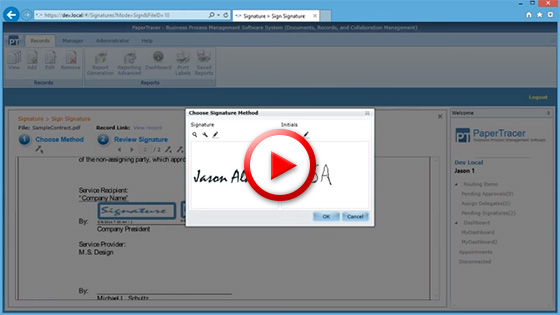E-Signature: The Facts and Capabilities
A handwritten signature has long been the glue between parties when making an agreement. It acknowledges that you are in fact who you say you are and that you have discussed and agree to what is being said in that document or contract.

Since signatures are often a necessity, paper documents and contracts easily and continuously pile up. Today businesses no longer have to surrender to the power of pen and paper. Thanks to technology the ability to have a document or contract signed and filed safely on your secure site within minutes is now possible by using an electronic signature or e-signature.
But don’t e-sign just yet! Consider the following before making an e-signature app or software purchase.
Is Electronic Signature Legal in My State?
When drawing up any contract or document that will require a signature, maintaining legality is essential. It is important to know the laws surrounding the contracts and documents that your business produces as well as if they prove intent and attribution from the signer for court to hold them legally binding should that need arise.
The United States and most other countries have adopted laws regarding e-signature. At the federal level in the U. S. e-signature users must comply with the Electronic Signatures in Global and National Commerce Act (ESIGN) which overlays statutes, authorizes replacing writings with electronic records, authorizes electronic signatures, and requires that Parties “opt-in” which may be shown by circumstances surrounding the signing. The state level definition released in the U. S. by the National Conference of Commissioners on Uniform State Laws (NCCUSL) in the Uniform Electronic Transactions Act (“UETA”) of 1999 broadly defines an e-signature as “an electronic sound, symbol, or process, attached to or logically associated with a contract or other record and executed or adopted by a person with the intent to sign the record.” All but three states of the United States (including Washington, D. C. and the U. S. Virgin Islands) have enacted the UETA. New York, Washington State, and Illinois have adopted their own statutes regarding electronic signature.
In New York the definition and stipulations regarding electronic signatures are in the Electronic Signatures and Records Act. It states that electronic signatures are legally binding like a handwritten signature and defined as “an electronic sound, symbol or process attached to or logically associated with an electronic record and adopted by a person as their signature.” Also stated is the exception that e-signatures cannot be applied to “negotiable instruments and other instruments of title where possession of the instrument is deemed to confer title” ie. checks, stock certificates, or motor vehicle titles.
Washington State passed the Washington Electronic Authentication Act which defines an electronic signature as “a signature in electronic form attached to or logically associated with an electronic record, including but not limited to a digital signature.” It also sets guidelines that stipulate certain documents like original wills, certified records of proceedings for purpose of appeal, negotiable instruments, and documents of foreign governments are unacceptable electronically signed and must be accompanied by a handwritten signature.
Illinois enacted the Electronic Commerce Security Act. Under it are the state’s stipulations on electronic documents and it defines electronic signature as “a signature in electronic form attached to or logically associated with an electronic record.” Illinois, like New York, will not accept electronic signature on negotiable instruments or instruments of title.
All of the states in America allow electronic signature, but their definitions may vary slightly as in the cases of New York, Washington State, and Illinois. In order to make an informed decision read the act or laws associated with your state or speak with an experienced contract lawyer to be sure that you are choosing the correct method of signature for your business documents.
Why Should I Use It in My Business?
Over time paper accumulates. This growth requires an increase in storage needs as well as the costs and other workflow pain points that are associated with them. E-signature gives businesses the ability to address some of the problems a business encounters with handling volumes of paper. Major benefits like increases in costs savings, time, and productivity are achievable over a short period.
E-signature is a secure effective way for your business to cut costs because it reduces your dependence on paper. A government study of Almeda County in California revealed that the chief costs of using paper are copying at 33% and distribution at 56%. Onsite storage and maintenance can also be a major expense. A small vertical file cabinet can cost as little as $55 and range up to $4800 for a large fire proofed file cabinet. If you take the number of standard sized file cabinets you have, multiplied by the standard size of 15.7sf, multiplied by the cost per square foot of your space, you will find that even the most basic of file cabinets becomes an expensive space holder. Don’t forget what will be spent on the paper itself, archival costs (i.e. offsite or onsite storage, boxes, etc.), and your miscellaneous filing supplies (i.e. hanging files, folders, tabs, etc.). All of these costs, plus the man power needed to maintain all of those documents yearly can drown your business. Electronically signing your documents will reduce these costs as well as the costs of mailing and couriering documents across town and back. Your savings from electronically signing and storing your documents are undeniable. Here is a form to help gauge your yearly expenses on paper.
| Expense | Formula | Total Annual Paper Expense |
|---|---|---|
| Paper | Monthly Paper Cost X 12 (Months) | |
| Paper File Storage | # filing cabinets X 15.7sf (Avg. File Cabinet size) X cost per square foot of space | |
| Onsite Paper Archive Storage | Number of shelving units (with bankers boxes), multiplied by the square footage used, multiplied by the cost of rental space per square foot | |
| Offsite Paper Archive Storage | Monthly offsite storage cost X 12 (Months) | |
| Printer/copy machines | Annual Rental Cost + Annual Maintenance Cost | |
| Printer/Copier Toners | Annual Total Purchase | |
| Office Supplies | Annual Total Purchase of Supplies (i.e. File Folders, Hanging Files, Tabs, Labels, Binders, etc.) | |
| Employee Time | Number hours per staff managing paper X # of staff X average hourly wage, X # workdays per year | |
| TOTAL COST |
Choosing a software that allows you the ability to have one secure location for electronically filing, storing, maintaining, and electronically signing your documents or contracts greatly increases productivity. E-signature eliminates the time spent searching for signed documents or documents in need of a signature because it allows a document to be securely signed, filed, and electronically available in minutes.
Using e-signature will also greatly reduce the time spent waiting on paper delivery methods. By reducing the amount of physical interaction involved in the transport and recovery of information e-signature allows documents to be more secure. Businesses gain more time to focus on current customers, add new customers, as well as more secure information!
How Does Electronic Signature Work?
Here is a short video demonstrating how the speed and ease of electronic signature can help to maintain a smooth paperless work flow at your business.
The More You Know:
- NY Times: 'Electronic Signatures in Global and National Commerce Act'
- Wikipedia: The History of Electronic Signature
- Electronic Signature and Records Association
- CA Civil Code Section 1633.1-1633.17
- Are Electronic Signatures Legal?
- Illinois General Assembly: Electronic Commerce Security Act
- Wikipedia: Electronic Signature
- Electronic Signatures and Records Act Guidelines
- Business Guide to Paper Reduction
- The Cost of Managing Paper: A Great Incentive to Go Paperless!

